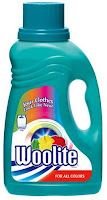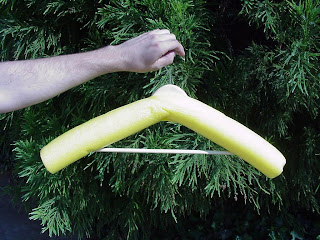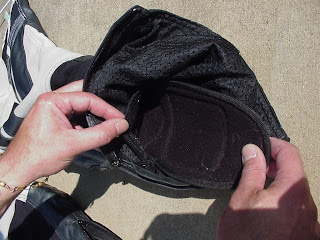Now that winter has set in on most of us, it is a good time to consider cleaning up the bike and accessories for spring riding. One of those accessories is your riding outfit. You do wear more than just a pair of jeans and a fashion jacket, right? I'm not talking about those. I'm talking about real motorcycle protective gear.
I always ride in a leather suit, but my suits are not new ones. I have scrounged them from pawn shops and on-line auction sites, so they were not all pristine when I got them. In addition, I have put on about 23,000 miles in the three years I have been riding, so the suits have seen year-round conditions including rain, road dirt, bug splats, ...and an unexpected taste of mud on the berm of a road.
Here is an article I wrote about cleaning leather at home that appeared in a local Greenville South Carolina magazine called Motorcycle Lifestyle. The magazine publisher, Norm Blore, is an accomplished motorcyclist and graphic artist. His magazine was one of my favorites, but, alas, it succumbed due to a lack of advertisers in the flagging economy, though a few issues can still be seen online at the link above.
Edit October 2012: The recommended washing product Woolite for All Colors is apparently no longer available. Use instead the Leather Therapy products referred to later in the article.
----------------------------------------------------------------------------------
Cleaning Leather Motorcycle Apparel at Home
By: Bucky
Disclaimer: Users of this procedure do so at their own risk. Neither the author nor this magazine is responsible for any loss suffered in connection with its use.
Cleaning of leather riding apparel is needed from time to time to remove the inevitable bug splats, road soil, perspiration salts, and the results of an occasional tumble from the machine.
Upon searching for sources of cleaning services, it was found that they can be expensive, and that some local cleaners may not have experience with multi-colored leathers. Therefore, those with limited funds or who lack a nearby cleaning source search for alternatives. A few on-line sources suggest that washing at home can be done, so being frugal, this rider/writer had to try it.
So far, three suits have been cleaned using this method, all with good results. The suit documented here is a white Fieldsheer one-piece that is about 15 years old. The other suits were a very bug-splatted and sweat-salt-encrusted Polo black/yellow two-piece and a Fieldsheer light gray/dark gray/black two-piece that had gone through a tumble.
The white suit that is the subject of this article has been down once onto a mostly grassy berm, mud soiling and scarring a few places on it, as shown in the photographs. The suit also had some minor soiling in the crook of the arms, and dark areas where the inside of the black riding boots touch the lower legs.
The washing method used is detailed here:
Test for Colorfastness
Use a dampened white towel edge to gently rub each color in the garment. If there is little or no transfer of color to the towel and if there is no noticeable loss of color on the garment, this indicates that the quality of the leather components is high enough to allow wetting while cleaning.
Products Needed
Woolite For All Colors Fabric Wash.
Lexol Leather Conditioner, Preservative.
Padded hanger for drying. Slitting a foam plastic swimming noodle and slipping it over a sturdy wooden coat hanger is an inexpensive way to make such a hanger. A noodle with a hole down the center works best. Make sure the ends of the noodle cover the wooden coat hanger and that the noodle extends slightly into the sleeves of the garment.
Washing Equipment and Settings
Domestic washing machine with as large a capacity as possible. Either top or front-loading type is acceptable. A top-loading extra-large capacity washer was used for this suit.
Set the water level to maximum.
Set the temperature for cold wash and cold rinse.
Set the agitation and spin speeds to delicate or slow.
Pre-Washing Procedure
Remove all armor and padding that is removable. These are usually fitted into pockets in the garment’s lining whose openings are closed with Velcro. Sometimes the armor is accessible in pockets from the exterior of the suit.
If the garment is very dirty with mud or bug splats, hang it where it can be rinsed with a garden hose.
Spray the garment with the hose until it is saturated.
Use a clean sponge and a soft bristle brush to remove dirt from the surface, from the stitching, and from the seams.
Rinse thoroughly.
Immediately begin the Washing Procedure below without allowing the garment to dry.
Washing Procedure
Turn the garment inside out to protect the leather from the washing machine agitator and from zipper abrasions. Close all zippers and Velcro.
Partially fill the washing machine tub.
Add 4 oz of Woolite For All Colors Fabric Wash. (Fill the Woolite bottle cap to the top.) Agitate for one minute.
Submerge the garment completely and distribute it evenly in the tub to reduce imbalance during the spin portion of cycle.
Wash only one item at a time.
Continue to full the tub to capacity. Set the agitation time for 12 minutes. When that time has elapsed, but before the wash water has drained, reset the washing machine timer for an additional 12 minutes.
When the second 12-minute agitation portion of the cycle is complete, allow the machine to complete its cycle.
Again set the washing machine to rinse, redistribute the garment in the tub, and allow it to fill and rinse a second time to thoroughly remove the detergent.
Meanwhile, clean the armor with mild detergent and a sponge, and the knee pucks with a brush. Rinse and set aside to air dry.
Treatment After Washing
Remove the garment from tub.
Turn it right side out. Do not wring it or stretch it excessively.
Hang it on a wide, padded hanger to avoid stretching the garment during drying.
Close all zippers and Velcro to help prevent the garment from stretching unevenly.
Two-piece suits can be zipped together and hung as one or can be hung separately. (When the pants of a two-piece suit are hung separately, the spring clips of the pants hanger may leave depressed areas in the leather.) If the garment is too heavy to hang, lay it flat on several bath towels.
While still wet from washing, apply Lexol Leather Conditioner, Preservative by spraying or wiping it on with a clean sponge. The conditioner should be applied until is just begins to run.
Use a clean cloth or sponge to smooth out runs, as these may cause streaking once the garment is dry. Straighten out the garment so it has as few folds in it as possible. Straighten the zipper flaps so they dry flat as well.
Drying
Allow to air dry on the hanger in a heated or air conditioned room. Do not dry near direct heat or in the sun. A circulating fan is helpful in speeding drying, especially when the humidity is high.
Occasionally, shake or “pat” the leather to manipulate the leather fibers and promote flexibility.
If laying flat to dry, turn the garment over frequently and exchange the bath towels for dry ones to allow all portions to dry.
The suit in this article took about four days to dry while hanging in an air-conditioned room with free air circulating around it.
Afterward
Once dry, again treat with Lexol Leather Conditioner, Preservative. Wipe off any excess.
Allow garment to further dry for a day or two.
Results
The suit is, in general, clean and bright. There is no noticeable running of the colors.
The leather is soft and supple.
The Lexol conditioner left a waxy finish that does not seem to cause excessive slipping on a synthetic leather motorcycle saddle.
The leather shrunk very slightly, probably to its original size.
The suit has been worn once since the washing, and it appears to have stretched a bit during that wearing, much as new leather would be expected to do.
The mud is almost all gone, except in some stitching and in scratches where the leather was abraded in the tumble.
The soil in the crook of the elbows was removed.
The marks on the lower legs from the inside of the boots were not removed by the washing process.
The sweat salt and stiffness in the other suit washed previously was removed without a trace.
These pictures taken after the washing process show the worst-soiled areas of the white suit.
Some of the procedures described above were recommended by the makers of Leather Therapy preparations for cleaning leather.
Their products have not been tried by the author, though they are specially formulated for leather cleaning at home. They recommend their Leather Infusion Wash in place of the Woolite For All Colors, and their Leather Infusion Rinse afterward. After that, use their Restorer/Conditioner if the garment seems dry. They have posted some videos that show the procedure.
This shady-looking biker dude is showing off the finished product.
Their products have not been tried by the author, though they are specially formulated for leather cleaning at home. They recommend their Leather Infusion Wash in place of the Woolite For All Colors, and their Leather Infusion Rinse afterward. After that, use their Restorer/Conditioner if the garment seems dry. They have posted some videos that show the procedure.
This shady-looking biker dude is showing off the finished product.
----------------------------------------------------------------------------------
Well, there you have it. Now there is no excuse for wearing dirty leathers -- unless you want people to think you ride a lot.
Oh, no. What have I done?
















No comments:
Post a Comment